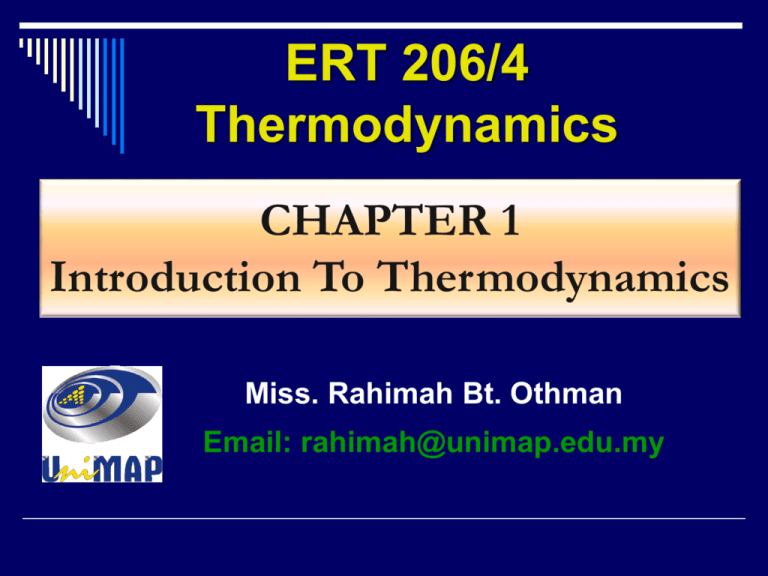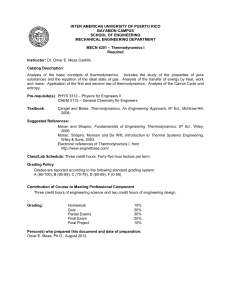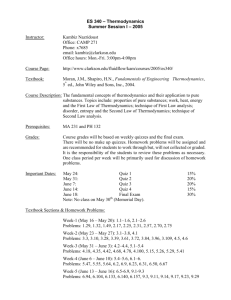THERMODYNAMICS: Definition
advertisement

ERT 206/4 Thermodynamics CHAPTER 1 Introduction To Thermodynamics Miss. Rahimah Bt. Othman Email: rahimah@unimap.edu.my COURSE OUTCOME 1 CO1) 1. Chapter 1: Introduction to Thermodynamics Identify and analyze scope, dimensions and units, measure of amount or size, force, temperature, pressure, work, energy and heat. 2. Chapter 2: The First Law and Other Basic Concepts 3. Chapter 3: Volumetric properties of pure fluids 4. Chapter 4: Heat effects 5. Chapter 5: Second law of thermodynamics 6. Chapter 6: Thermodynamics properties of fluids THERMODYNAMICS: Definition * Thermodynamics Definition. (from the Greek θέρμη therme, meaning "heat“ and δύναμις, dynamis, meaning "power") - is the study of energy conversion between heat and mechanical work, and subsequently the macroscopic variables such as temperature, volume and pressure. THERMO = HEAT AND TEMPERATURE DYNAMICS = MOTION THERMODYNAMICS: Definition * Initially, thermodynamics is the study of the flow of heat to produce mechanical energy that could be used for locomotive; - after that is used for steam engines, turbines, pumps, air conditioners etc. * Because such equipment also used in chemical/ bioprocess plant, it is also important for those engineers to learn the fundamental of such equipment. THERMODYNAMICS: Example - The production of chemicals, polymers, pharmaceuticals and other biological materials, and oil and gas processing, all involve chemical or biochemical reaction that produce a mixture of reaction product. (e.g:Production of acetic acid from ethanol using Acetobacter aceti bacteria) C2 H 5OH O2 CH 3CO2 H H 2O 1. These must be separated from the mixture and purified to result in product of societal, commercial, or medicinal value. 2. These is the area where thermodynamics plays a central role in bioprocess eng. 3. Separation processes, e.g. distillation are designed based on information from thermodynamics Dimensions and Units Measures of amount or size Force Temperature Thermodynamics Pressure Work Energy Heat Dimensions and Units Measures of amount or size Force Temperature Thermodynamics Pressure Work Energy Heat Dimensions and Units - Dimension is recognize through our sensory perceptions and not definable without the definition of arbitrary scales of measure, divided into specific units of size. - The units have been set by international agreement, and are codified as the International System of Units (SI). • Note: See Table 1.1 for Prefixes (eg: deca, hecto, kilo, etc.) of SI units. (eg: 1 cm = 10-2 m, 1 kg = 103 g) Dimensions and Units Measures of amount or size Force Temperature Thermodynamics Pressure Work Energy Heat Measures of amount or size • Three measures of amount or size are in common use: Mass, m ; Number of moles, n ; Total volume, Vt • Mass, m divided by the molar mass M (molecular weight) to yield number of moles; m n M or m Mn Total volume, divided by the mass or number of moles of the system to yield specific or molar volume. • Specific volume: Vt V m • Molar volume: Vt V n or V t mV or V t nV Dimensions and Units Measures of amount or size Force Temperature Thermodynamics Pressure Work Energy Heat Force SI unit Metric engineering system units Newton (N) Kilogram force (kgf) F = ma 1 F ma gc 1 kgf 1 x 1 kg x 9.80665 ms 2 gc gc 9 .80665 kg m kg f 1 s 2 * Note : The kilogram force is equivalent to 9.80665 N Force Example 1.1 An astronaut weighs 730 N in Houston, Texas, where the local acceleration of gravity is g = 9.792 ms-2. What are the astronaut’s mass and weight on the moon, where g = 1.67 ms-2. Solution With a = g, Newton’s law is : F = mg. Hence; m F 730 N 1 2 74 . 55 Nm s 2 g 9.792ms Because the newton N has the unit kg m s-2, m 74.55 kg This mass of the astronaut is independent f location, but weight depends on the local acceleration of gravity. Thus on the moon the astronaut’s weight is; F (moon) mg (moon) 74.55 kg x 1.667 ms 2 or F(moon) 124.5 kgms -2 124.5 N Dimensions and Units Measures of amount or size Force Temperature Thermodynamics Pressure Work Energy Heat Temperature • Temperature is commonly measured with liquid-in-glass thermometers, wherein the liquid expands when heated. Dimensions and Units Measures of amount or size Force Temperature Thermodynamics Pressure Work Energy Heat Pressure • The pressure P exerted by a fluid on a surface is defined as the normal force exerted by the fluid per unit area of the surface. SI unit Metric engineering system units Pascal (Pa) Kilogram force per square centimeter (kgf cm-2) • The primary standard for pressure measurement is the dead-weight gauge in which a known force is balanced by a fluid pressure acting on a known area. F mg A A F mg Ahg P hg A A A P Force Example 1.2 A dead-weight gauge with a 1 cm diameter piston is used to measure pressures very accurately. In a particular instance a mass of 6.14 kg (including piston and pan) brings it into balance. If the local acceleration of gravity is 8.82 ms-2, what is the gauge pressure being measured? If the barometric pressure is 748 Torr, what is the absolute pressure? Solution The force exerted by gravity on the piston, pan and weights is F mg (6.14)(9.82) 60.295 N F 60.295 2 Gauge pressure 76 . 77 Ncm A (1 / 4)( )(1) 2 The absolute pressure is therefore; or P 76.77 (748)(0.013332) 86.74 Ncm2 P 867.4 kPa Force Example 1.3 At 27oC (300.15 K) the reading on a manometer filled with mercury is 60.5 cm. The local acceleration of gravity is 9.784 ms-2. To what pressure does this height of mercury correspond? Solution Recall the equation in the preceding text, P = hρg. At 27 oC (300.15 K) the density of mercury is 13.53 g cm-3. Then, P 60.5 cm x 13.53 gcm 3 x 9.784 ms 2 8,009 gms 2cm 2 or P 8.009 kgms 2cm 2 8.009 Ncm2 80.09 kPa 0.8009 bar Dimensions and Units Measures of amount or size Force Temperature Thermodynamics Pressure Work Energy Heat Work • Work, W is performed whenever a force acts through a distance. dW Fdl Vt dW PAd A dW PdV t W V2t t PdV t V1 * Note: The minus sign ‘-’ the volume change is positive, and the minus sign is required to make the work negative. Dimensions and Units Measures of amount or size Force Temperature Thermodynamics Pressure Work Energy Heat THANK YOU TUTORIAL 1 - QUESTIONS Problems : 1.3, 1.4, 1.11, 1.14, 1.22 Reference Book: Smith, J.M., Van Ness, H.C. and Abbort, M.M., Introduction to Chemical Engineering Thermodynamics, Seventh Edition, McGraw-Hill, 2005.







